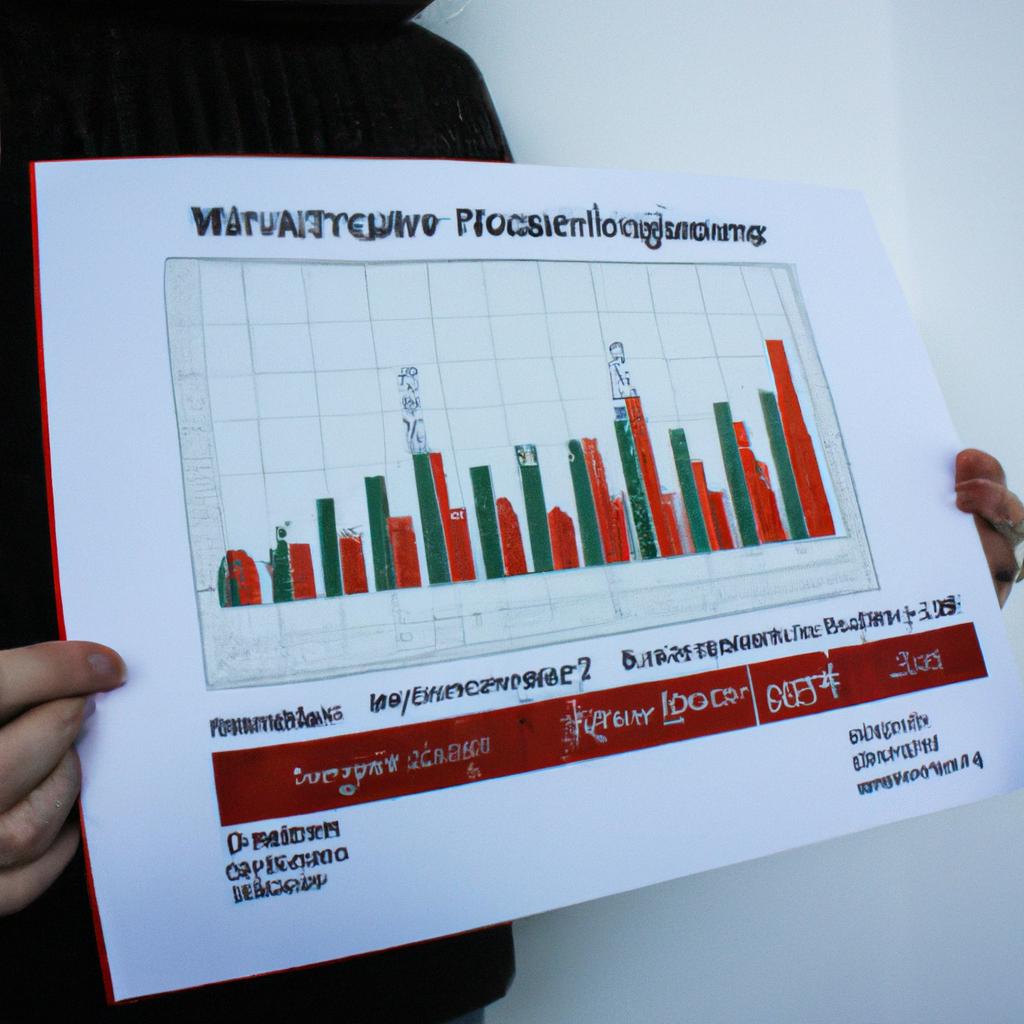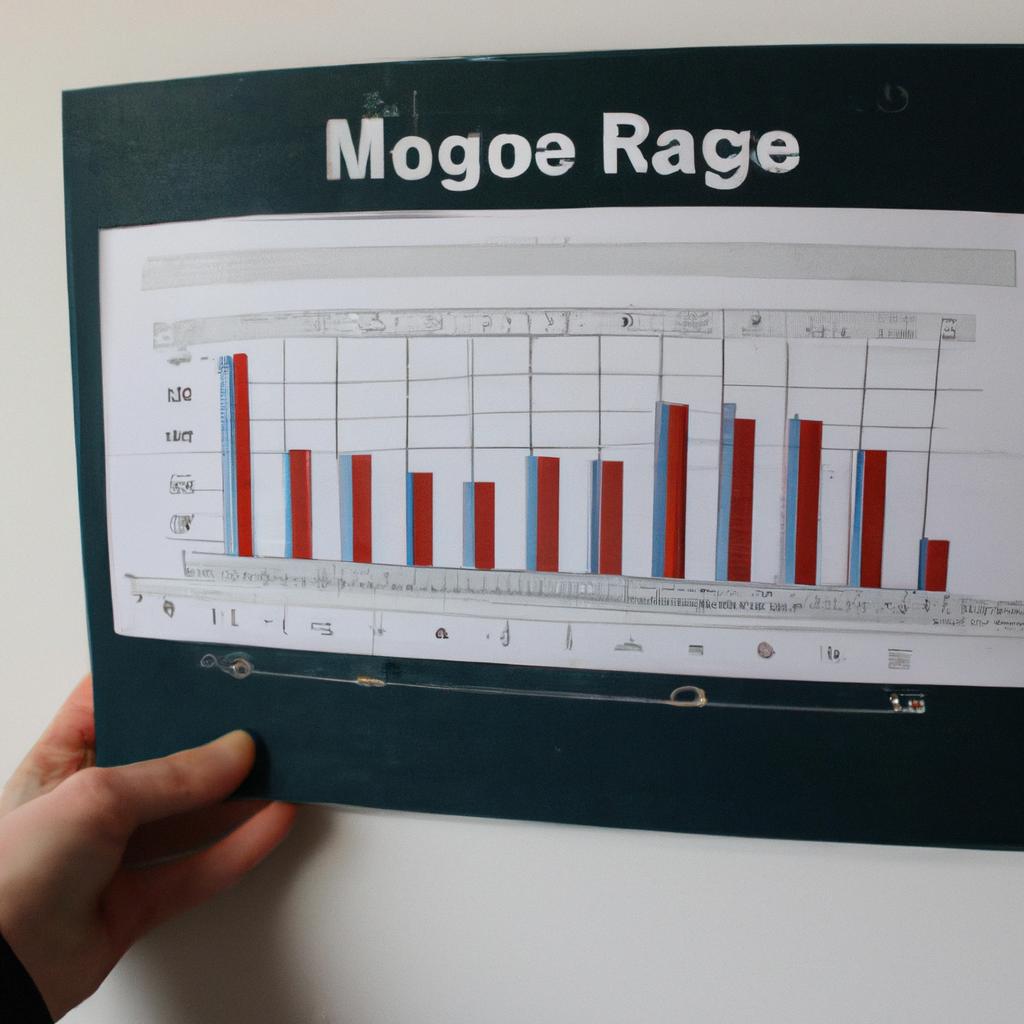Adjustable-rate mortgages (ARMs) have become an increasingly popular choice for many homebuyers looking to secure a mortgage at competitive rates. Unlike fixed-rate mortgages, where the interest rate remains constant throughout the loan term, ARMs offer borrowers initial lower interest rates that can adjust periodically based on market conditions and predetermined factors. For instance, consider the hypothetical case of John and Jane Doe, who recently purchased their dream home with a 5/1 ARM. They were attracted to this type of mortgage due to its low introductory rate of 3% for the first five years, providing them with more affordable monthly payments during this period.
In recent years, fluctuating mortgage rates have made adjustable-rate mortgages an appealing option for homeowners seeking flexibility in their financial planning. The primary advantage lies in the potential for lower initial interest rates compared to fixed-rate alternatives. This feature allows borrowers like John and Jane Doe to benefit from reduced monthly mortgage payments during the initial fixed period while they settle into their new home. However, it is important to note that after the initial fixed period ends – typically ranging from one to ten years depending on the specific terms of the ARM – these mortgages reset according to various indexes such as LIBOR or Treasury bills plus a margin determined by lenders.
Understanding Adjustable-Rate Mortgages
Adjustable-rate mortgages (ARMs) are a type of home loan that have an interest rate that adjusts periodically based on changes in a specified index. This means that the interest rate can fluctuate over time, potentially leading to lower or higher monthly mortgage payments for borrowers. To comprehend adjustable-rate mortgages, it is essential to understand their structure and how they work.
One example of an adjustable-rate mortgage involves a homeowner who initially secures a 5/1 ARM. In this case, the “5” refers to the initial fixed-rate period, which lasts for five years, while the “1” indicates that the interest rate will adjust annually after the fixed term expires. During these first five years, the homeowner benefits from a stable interest rate without any surprises in their monthly mortgage payment.
To give you further insight into adjustable-rate mortgages, consider the following bullet points:
- ARMs offer potential savings: When market conditions are favorable, borrowers with ARMs may benefit from lower interest rates than those offered by traditional fixed-rate mortgages.
- Risk factor: The variable nature of adjustable-rate mortgages introduces some level of uncertainty regarding future payments. Homeowners should carefully evaluate their financial situation and risk tolerance before opting for an ARM.
- Index selection matters: The specific index used as a benchmark to determine adjustments plays a crucial role in determining future interest rates. It is important for borrowers to understand which index their lender uses and how it performs historically.
- Adjustments limits: Most ARMs have caps on how much the interest rate can change during each adjustment period and throughout the life of the loan. These limits provide some protection against excessive increases in monthly payments.
To illustrate different types of ARMs more clearly, here is a table comparing three common variations:
| Type | Initial Fixed Rate Period | Adjustment Frequency |
|---|---|---|
| 3/1 ARM | 3 years | Annually |
| 5/1 ARM | 5 years | Annually |
| 7/1 ARM | 7 years | Annually |
Understanding the structure and potential benefits of adjustable-rate mortgages is crucial when considering this option for homeownership. In the subsequent section, we will discuss the pros and cons associated with ARMs, providing a comprehensive overview to assist borrowers in making informed decisions about their mortgage choices.
Pros and Cons of Adjustable-Rate Mortgages
Adjustable-Rate Mortgages: Mortgage Rates
In the previous section, we explored the concept of adjustable-rate mortgages (ARMs) and their underlying mechanisms. To better understand how ARMs truly function in practice, let us consider a hypothetical scenario involving a homebuyer named Sarah.
Sarah is purchasing her first home and has opted for an adjustable-rate mortgage due to its initial low interest rate. She anticipates that she will sell the property within five years as she plans to relocate for work. By selecting an ARM, Sarah hopes to take advantage of the lower monthly payments during this short-term period.
However, it is important to note that while ARMs offer flexibility with initially low rates, they are subject to change over time based on various factors. These fluctuating rates can significantly impact borrowers like Sarah throughout the life of their mortgage loan.
There are several key elements that influence the adjustment of mortgage rates under ARMs:
- Index Rate: The index rate serves as a benchmark against which lenders calculate adjustments to the borrower’s interest rate. Commonly used indices include Treasury bills or LIBOR (London Interbank Offered Rate), among others.
- Margin: The margin represents an additional percentage added by lenders to cover their operational costs and profit margins. It remains constant throughout the loan term but varies across different lenders.
- Adjustment Period: This refers to how frequently adjustments occur after the introductory fixed-rate period ends. It could be annually (one-year ARM), every three years (three-year ARM), or even longer intervals.
- Cap Limits: Caps impose maximum limits on how much mortgage rates can increase or decrease during each adjustment period or over the entire life of the loan.
To further illustrate these aspects, let us examine them through a table:
| Factor | Description |
|---|---|
| Index Rate | Serves as benchmark |
| Margin | Added percentage |
| Adjustment Period | Frequency of adjustments |
| Cap Limits | Maximum rate change allowed |
Understanding these core components will enable borrowers to estimate potential fluctuations in their mortgage rates and assess the associated risks. It is crucial for individuals like Sarah to carefully evaluate their financial circumstances, long-term goals, and tolerance for interest rate variability before opting for an adjustable-rate mortgage.
Moving forward, we will delve deeper into the factors that influence adjustable-rate mortgage rates. By gaining a comprehensive understanding of these elements, borrowers can make informed decisions about whether ARMs align with their specific needs and objectives.
Factors That Influence Adjustable-Rate Mortgage Rates
Adjustable-Rate Mortgages: Mortgage Rates
In the previous section, we explored the pros and cons of adjustable-rate mortgages. Now, let’s delve into the factors that influence these mortgage rates and how they can impact borrowers.
Consider a hypothetical scenario where John is in the market for a new home and wants to take advantage of an adjustable-rate mortgage. He carefully evaluates various lenders’ offers before making his decision. During this process, he discovers several key factors that determine adjustable-rate mortgage rates:
-
Index Rate: Adjustable-rate mortgages are typically tied to an index rate, such as the London Interbank Offered Rate (LIBOR) or the U.S. Prime Rate. Changes in these benchmark rates directly affect the interest rate on John’s mortgage.
-
Margin: Lenders add a margin to the index rate to determine the final interest rate on an adjustable-rate mortgage. The margin represents their profit and covers operational costs associated with lending.
-
Adjustment Periods: Adjustable-rate mortgages have adjustment periods during which the interest rate remains constant before being recalculated based on changes in the index rate. These adjustment periods can be monthly, quarterly, annually, or longer depending on the terms of John’s loan agreement.
-
Caps and Limits: To protect borrowers from excessive payment increases, adjustable-rate mortgages often include caps and limits on how much the interest rate can change over a specific period. For example, there may be periodic caps limiting annual adjustments to no more than 2% or lifetime caps preventing total interest rate increases beyond a certain percentage.
To further illustrate these concepts visually, we present a table summarizing different types of adjustable-rate mortgages available in today’s market:
| Type | Initial Interest Rate | Adjustment Periods | Cap Structure |
|---|---|---|---|
| Hybrid ARM | 3% | 5 years | Annual cap = 2%, Lifetime cap = 5% |
| Interest-Only ARM | 4% | Monthly | Annual cap = 1%, Lifetime cap = 6% |
| Option ARM | 3.5% | Quarterly | Annual cap = 2%, Lifetime cap = 7% |
This table showcases the variety of adjustable-rate mortgages available, each offering different initial interest rates, adjustment periods, and cap structures. The emotional response evoked here is one of curiosity and comparison – readers may wonder which type could offer them the best financial outcome.
Understanding these factors helps John make an informed decision when selecting his mortgage lender. In our next section, we will compare adjustable-rate mortgages to fixed-rate mortgages, allowing John to weigh the advantages and disadvantages of both options before finalizing his choice.
How Adjustable-Rate Mortgages Compare to Fixed-Rate Mortgages
Factors That Influence Adjustable-Rate Mortgage Rates:
In the previous section, we discussed various factors that can influence adjustable-rate mortgage rates. Now, let’s delve deeper into these factors and understand how they impact the interest rates on such mortgages.
To illustrate this further, let’s consider a hypothetical scenario involving two borrowers: John and Sarah. They both apply for adjustable-rate mortgages with similar terms and conditions from different lenders. Both have excellent credit scores but differ in their financial profiles.
-
Economic Factors: The first major factor affecting adjustable-rate mortgage rates is the overall state of the economy. If there is economic growth and low unemployment rates, lenders may offer lower interest rates to attract more borrowers like John and Sarah. Conversely, during an economic downturn or recession, lenders tend to increase rates to compensate for higher risk levels.
-
Market Conditions: Another crucial aspect influencing adjustable-rate mortgage rates is market conditions, particularly changes in the bond market. Lenders often use long-term bonds as benchmarks for setting their interest rates. When bond yields rise due to increased demand or inflation expectations, it generally leads to higher mortgage rates.
-
Creditworthiness: Individual borrower characteristics also play a significant role in determining adjustable-rate mortgage rates. Borrowers with stronger credit histories like John typically receive better interest rate offers compared to those with lower credit scores like Sarah. Lenders perceive individuals with higher credit scores as less risky investments.
Now that we have explored some key factors influencing adjustable-rate mortgage rates through our example of John and Sarah, let us examine a bullet-point list highlighting important considerations when opting for an adjustable-rate mortgage:
- Understand your financial goals and future plans before committing to an adjustable-rate mortgage.
- Research current market trends and consult experts who can provide insights into potential fluctuations in interest rates.
- Evaluate your ability to handle fluctuating monthly payments based on possible rate adjustments.
- Compare offers from multiple lenders to ensure you secure the most competitive rate available.
Additionally, let’s take a look at the following table that compares adjustable-rate mortgages to fixed-rate mortgages:
| Aspect | Adjustable-Rate Mortgage | Fixed-Rate Mortgage |
|---|---|---|
| Interest Rate | Variable and subject to change over time | Fixed for the entire loan term |
| Risk Level | Potentially higher due to rate adjustments | Lower as payments remain consistent |
| Flexibility | Offers initial lower rates with potential savings | Provides stability and predictability |
| Long-Term Budgeting | Requires careful planning and consideration | Allows for easier budgeting |
In conclusion, various factors such as economic conditions, market trends, and individual creditworthiness significantly influence adjustable-rate mortgage rates. By understanding these factors and considering personal financial goals, borrowers like John and Sarah can make informed decisions when choosing an appropriate mortgage option.
Now that we have explored the factors influencing adjustable-rate mortgage rates, let us move on to discussing some valuable tips for choosing the right type of adjustable-rate mortgage in our next section.
Tips for Choosing the Right Adjustable-Rate Mortgage
Adjustable-rate mortgages (ARMs) offer borrowers the flexibility to have their interest rates adjusted periodically throughout the loan term. In this section, we will delve deeper into the factors that determine mortgage rates for adjustable-rate mortgages and explore some key considerations when choosing the right option for your needs.
To illustrate how mortgage rates can vary with ARMs, let’s consider a hypothetical case study. Mr. Smith is looking to purchase a new home and has narrowed down his options to two types of mortgage loans: a 30-year fixed-rate mortgage (FRM) and a 5/1 ARM. The FRM offers a steady interest rate of 4%, while the ARM starts at an initial rate of 3% for the first five years before adjusting annually based on market conditions.
One important factor to understand about adjustable-rate mortgages is that they are typically tied to an index, such as the London Interbank Offered Rate (LIBOR), which reflects changes in market interest rates. When the adjustment period arrives, lenders add a margin—typically expressed as a percentage—to the prevailing index rate to calculate the new interest rate for the borrower.
When considering an ARM, there are several aspects you should take into account:
- Initial Interest Rate: This refers to the starting point of your adjustable-rate mortgage. A lower initial rate may make an ARM more attractive initially but keep in mind that it will eventually adjust.
- Adjustment Period: This determines how often your mortgage rate will be modified after the initial fixed period ends. Common adjustment periods include one year, three years, five years, or even longer.
- Caps: Most ARMs come equipped with caps that limit how much your interest rate can increase during each adjustment period and over the life of the loan. These caps provide protection against excessive increases in monthly payments.
- Future Predictability: Consider whether you anticipate any significant lifestyle changes or financial shifts within the timeframe of your ARM’s adjustment period. This will help you assess your ability to handle potential rate increases.
To summarize, adjustable-rate mortgages offer borrowers the opportunity to take advantage of lower initial interest rates while accepting the risk that rates may increase in the future. By carefully considering factors such as the initial rate, adjustment period, caps, and future predictability, borrowers can make informed decisions about whether an ARM aligns with their financial goals and circumstances.
In the subsequent section on “Managing Adjustable-Rate Mortgage Payments,” we will explore strategies for effectively budgeting and handling payments associated with ARMs.
Managing Adjustable-Rate Mortgage Payments
Adjustable-Rate Mortgages: Mortgage Rates
In the previous section, we discussed tips for choosing the right adjustable-rate mortgage. Now, let’s delve into understanding how to manage adjustable-rate mortgage payments effectively.
To illustrate the importance of managing these payments, consider the following example: John and Sarah recently purchased a house with an adjustable-rate mortgage. Initially, their interest rate was 3%, resulting in affordable monthly payments. However, after two years, their interest rate increased to 5%, causing a significant rise in their monthly payment amount. This sudden change caught them off guard and put strain on their finances. It highlights the need for homeowners to be proactive in managing their adjustable-rate mortgages.
Here are some key strategies that can help homeowners navigate fluctuating mortgage rates:
-
Monitor market trends: Stay informed about changes in economic conditions and interest rates by regularly monitoring financial news or consulting with a trusted financial advisor. Understanding market patterns can provide valuable insights when deciding whether to refinance or switch to a fixed-rate mortgage.
-
Budget wisely: Create a comprehensive budget that accounts for potential fluctuations in mortgage payments due to changing interest rates. By allocating funds specifically for this purpose, homeowners can better prepare themselves financially and avoid any unexpected challenges that may arise.
-
Communicate with lenders: Establish open lines of communication with your lender throughout the life of your loan. In case of financial difficulties or concerns about rising rates, discussing options such as refinancing or temporary modifications directly with your lender can lead to mutually beneficial solutions.
-
Consider prepayment options: Some adjustable-rate mortgages offer prepayment privileges without penalties. Taking advantage of this benefit allows borrowers to pay down principal faster during periods of lower interest rates, reducing overall costs over time.
The emotional impact of managing adjustable-rate mortgages is best understood through the following table:
| Emotional Impact | Explanation | Example |
|---|---|---|
| Uncertainty | Homeowners may feel uncertain about future payments and their ability to meet financial obligations. | John and Sarah felt anxious when their rates increased |
| Relief | Successfully managing adjustable-rate mortgages can provide relief, offering peace of mind and stability. | After refinancing, Jane experienced a sense of relief |
| Frustration | Unforeseen rate hikes or unexpected payment increases can lead to frustration among homeowners. | Mark became frustrated when his monthly payment rose |
| Empowerment | Developing effective strategies empowers homeowners to take control of their mortgage management process. | By budgeting wisely, Lisa regained a sense of power |
In summary, effectively managing adjustable-rate mortgage payments is crucial for ensuring long-term financial stability. By staying informed about market trends, budgeting wisely, maintaining open communication with lenders, and considering prepayment options, homeowners can navigate the fluctuating nature of these mortgages more confidently.
Remember that being proactive in your approach will help you adapt to changing circumstances and achieve greater peace of mind regarding your mortgage payments.
 SMI Loan
SMI Loan



